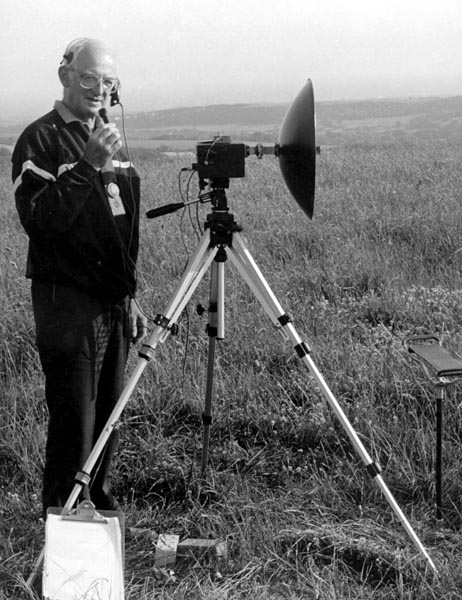G3JMB

Jack at Chanctonbury Hill Summer 1987
Jack Brooker MBE became a silent key on Thursday 12 February 2004 and will be much missed by radio amateurs both in the UK and throughout the world. Jack was a true gentleman, always ready to help and patient with others. He enjoyed many aspects of the hobby and in each of his many spheres of interest he would help others to develop an interest or to gain greater skills.
Jack was first licensed in 1953 and spent, like all others at the time, a probationary year on HF CW with home brew equipment. My earliest memories of him as an operator were on Sunday morning RSGB news nets and on 144 MHz AM. With a crystal controlled five watt 2M rig he would call CQ as Golf Three Japan Mexico Boston and would end the call with 'now tuning low to high for any possible calls'. Always his ears could detect callsigns from across the room when I was struggling to make them out with the aid of filters and headphones.
In the RAF in World War Two Jack was one of the special few who were trained on RDF (Radar) and he served in several places including Orkney where in addition to the delights of a 1MW Chain Home Radar and continuously pumped demountable valves, he would repair radios for the islanders. He was later posted as a Radar instructor to London where frequently they saw the equipment only twelve hours prior to instructing others how to service it.
The homebrew HF rig later gave way to a Heathkit HW100 that was made on the dining room table with the help of his daughter (now G3ZZZ). 35 years on the rig still works as well as ever. In the 1970s a 2M FM mobile transceiver was built. This was a Mid Sussex ARC club project designed by G3WPO and known as the 'Whoppo Box'. Articles in Practical Wireless in 1981 introduced the black arts of 10GHz. Having installed his own central heating system a bit of waveguide plumbing was taken in his stride. Microwaves became a real passion for the rest of his life. In 1987 Jack was one of the early pioneers of operating on 10 GHz narrowband. Given that earlier systems had used an IF of up to a megahertz bandwidth to capture a drifting signal, working with a bandwidth of 2.4 kHz was not for the faint hearted and constructing with 1pF surface mount capacitors of 2 mm square was quite a challenge to eyes that had viewed the world for over 70 years. Getting used to fine needle soldering techniques was a far cry to wielding a 120 Watt Solon iron.
As a competitive being, Jack loved contest operating but was happy to exceed his own targets rather than having to win and was a regular contributor to the December fixed station 2M contest. In the amateur spirit of 'self training' he adopted many new techniques for portable microwave operating. His original PW EXE was powered by a small gell cell and alignment was by compass alone. His final one Watt 10 GHz narrowband equipment featured a control box for operating from within the vehicle, a switched mode 24 Volt to 13.8 Volt converter and an accurate tripod mounted rotator with remote digital readout. Of course the bearings and distances were evaluated by a pocket computer.
When health limitations made all day expeditions to hilltops difficult, Jack returned to the shack. Chasing 2M sporadic E, 70 cm's, and HF were supplemented in 2003 by the new challenge of 6M. He was very pleased to work his first 6M sporadic E, days after putting the beam on the tower.
Away from the mic Jack was a founder member of the Crawley club, President of the Mid Sussex and a member of the UK microwave Group. He supported the RSGB for over 50 years and served as a regional representative in the 1970s. He was an active contributor to microwave Round Table meetings for nearly twenty years. His last contribution was made in September 2003 at Crawley. He held many certificates for operating achievements, including two No.1's for microwave work.
Jack was an inspiration to us all. He lives on in our memories.
Allan (G8LSD)